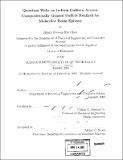Quantum wells on indium gallium arsenic compositionally graded buffers realized by molecular beam epitaxy
Author(s)
Choy, Henry Kwong Hin, 1974-
DownloadFull printable version (10.43Mb)
Other Contributors
Massachusetts Institute of Technology. Dept. of Electrical Engineering and Computer Science.
Advisor
Clifton G. Fonstad, Jr.
Terms of use
Metadata
Show full item recordAbstract
For a long time, there has been a desire to extend the emission wavelength of GaAs-based quantum well lasers, with the aim of eventually replacing InP with GaAs as the substrate of choice for communication applications. Using dilute nitride GaInAsN QWs or InAs quantum dots, emission wavelengths have successfully been extended to 1.3 m, but significant difficulties have been met going beyond 1.3 m. In this thesis, we present an alternative approach, namely, the molecular beam epitaxy (MBE) growth of quantum wells on top of indium gallium arsenic compositionally graded buffers, with the indium composition in the buffers linearly graded from 0% to 15% or 20%. We observed that one can obtain strong quantum emission on top of such graded buffers only under a very restricted range of growth conditions, detailed in this thesis, which are not compatible with the subsequent growth of the aluminum-containing barriers necessary for carrier confinement. Furthermore, upon proper ex-situ annealing, it was able to obtain QW emission as strong as, sometimes even stronger than, that from QWs pseudomorphically grown on GaAs.However, when even slight tensile or compressive strain was added to the QWs, severe degradation occurred, which was likely related with the amount of surface roughness induced by the crosshatches developed during and after the growth of the graded buffers. Temperature dependent photoluminescence was employed as a tool to investigate the relationship between the ex-situ annealing, strain and quantum well photoluminescence. It was found that there was a significant PL decay mechanism between 50K to about 250K for the aluminum containing unannealed quantum well samples. For the unstrained ones, this mechanism could be removed effectively by annealing. However, strain in quantum well was observed to retard this removal. The same observations were made in both the pseudomorphically and metamorphically grown samples, but the metamorphic ones seemed to suffer more from the retardation.Finally, the theoretical modeling of the photoluminescence temperature dependence was reformulated such that physical processes or band diagram features could be related to the measurement results. Only under restricted circumstances, our formulation was found to be identical to the existing, commonly used, description of the photoluminescence temperature dependence.
Description
Thesis (Ph. D.)--Massachusetts Institute of Technology, Dept. of Electrical Engineering and Computer Science, 2005. Includes bibliographical references (p. 161-174).
Date issued
2005Department
Massachusetts Institute of Technology. Department of Electrical Engineering and Computer SciencePublisher
Massachusetts Institute of Technology
Keywords
Electrical Engineering and Computer Science.